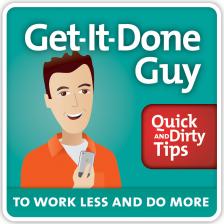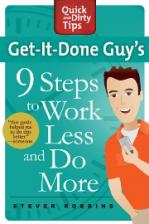How to Write a Great Resume (Part 3)
Once you have the basic flow of your resume, properly word-smithing each sentence can boost its effectiveness. Get-It-Done Guy has priceless insight into how to make your resume stand out from the crowd.

Today we’ll do a deep dive into the details of the individual resume entries themselves. They say the Devil is in the details, so bring your pitchfork; it’s gonna be a fun ride.
Sponsor: Get more things done with your team! Get your free 30-day premium subscription of Wrike, a popular app that makes managing tasks much more efficient and fun.
People Scan From Top to Bottom
Did I mention that hiring managers and employers will scan your resume? If nothing else, pound that into your brain. They’ll read the major headings and the first few words of each sentence. If you use a long sentence, they’ll never get to the end of it. If you use normal prose, they’ll fall asleep. What matters most is the first couple of sentences under each job, and the first few words of each sentence.
People often format a job entry as a paragraph of text briefly describing the job, followed by bullet points that list specific accomplishments. If you choose that format, these tips apply to each sentence in the paragraph, and each bullet point.
Every Sentence Must Convey Your Value
I’ve read resume entires that start like this: “I was a Product Manager in the Zombie Domination Army (ZDA for short), 14th Division. The ZDA is a collection of reanimated book club members in search of the perfect novel.” Wrong! The reader doesn’t care what the ZDA is. Remember we’re telling the story of you and your value to the company. The ZDA is just a footnote in that story.
Here’s how I’d write that same resume entry: “Managed projects for ZDA, 14th Division.” Boom! 27 words down to 7, keeping everything that’s relevant. Less is more, because people scan.
If you think you need a company description for your bullet points to make sense, that means you need to reword your bullet points.
Start Each Entry with an Active Verb
Did you notice “I was a product manager” became “Managed projects” in my rewrite? That’s because people scan, and you want the first word of your sentence to be the most powerful. Start each entry with a verb. I prefer to use past-tense verbs, even for my current job, but you can use present tense for your current job if you want.
- Developed world domination plans.
- Acquired zombie reanimation powder.
- Raised zombie army.
- Preserved zombie integrity with daily formaldehyde regime.
Put Bullet Points in Order of Importance

- Refilled Zombie formaldehyde tanks daily.
- Successfully conquered 50 cities in 4 days, liberating 20 tons of Oreo Ice Cream cake.
Start with the conquering bullet point.
Emphasize Results
Your story is that success follows you around like paparazzi follow Lady Gaga. Don’t force the reader to relate your experiences to their needs. Do it for them. In each bullet point, stress the success you produced. “Successfully conquered 50 cities in 4 days” is a result. It’s hot. “Walked up and down the troops and reattached limbs that had fallen off” is an action, and it’s not hot.
Concentrate on the results the employer would value, which of course you know from your research. Results might include increasing sales, boosting morale, establishing critical relationships, saving money, building infrastructure, bringing on better employees, speeding up product development, reducing defects, or increasing the salary of hiring managers.
List one result per sentence or bullet point. “Conquered 50 cities” and “Liberated 20 tons of Oreo Ice Cream cake” are both benefits. Make them separate bullet points. Otherwise the Oreo Ice Cream cake gets buried at the end of the sentence, which defeats the whole purpose of liberating it to begin with.
And include numbers, if possible. People like numbers. Especially big ones. But don’t include numbers just to have impressive numbers. An entry that says “Managed projects at $5 billion zombie reanimation center” is dumb. The $5 billion is an impressive credential for the company, but not for you. It’s obviously there to sound impressive, which makes the reader wonder why you felt you had to resort to sneaky language tricks to sound impressive. “Managed $5 billion reanimation center” is impressive, because now the $5 billion is directly about what you did, not about the company apart from you.
Use Concrete, Visual Language

- Decreased loading time for Santa’s Sled by dancing the lambada—the Forbidden Dance—to motivate dozens of scantily-clad elves.
Or
- Optimized supply chain logistics for yearly youth behavior-reinforcement initiative through visual stimulus generated by physiological resonance.
What’s flashing through your mind right now? Clearly images from the 1990 movie, Lambada: The Forbidden Dance. That’s because concrete imagery is memorable. Most jobs have little concrete imagery, since the only thing concrete about our jobs are the grey walls surrounding our beige cubicles. Scantily-clad elves would be escorted out of our workplace by the police for indecent exposure. But you can still make your verbs memorable.
Everyone wants great leaders and managers, but “led” and “managed” are weak verbs. There’s nothing visual about them. Ask yourself how you actually spent your time. Then use that to guide you. “Led 5-person team: Communicated vision. Prioritized weekly team activities. Coordinated departmental efforts. Determined goals. Coached people. Linked 14th Divison goals to overall ZDA domination plans. Developed employee professional development paths. Evaluated performance. Resolved conflicts.” Use “led” or “managed” to set the frame, and move immediately into concrete, active verbs.
Vivid language is worth the time. Today’s keyword-packed resumes sound generic. Memorable is rare. “Established distribution channels” Yawn. “Caused Zombie Scooter product line to fly off the shelves by negotiating with toy store buyers.” Much more memorable.

People scan, so you’ll arrange your bullet points and sentence words so the punch is at the start. You’ll use active verbs that make your value and results shine. Plus you’ll use concrete language that makes pictures in people’s minds.
In episode 4 of this 3-part series (the only 3-part series with 33% more parts!), we’ll cover how to write a resume if you’re changing career paths or applying for a job early in your career.
I’m Stever Robbins. I help high achievers turbo-charge their careers. If you want to know more, visit Stever Robbins.
Work Less, Do More, and have a Great Life!
Zombie image courtesy of Shutterstock.
You May Also Like…






